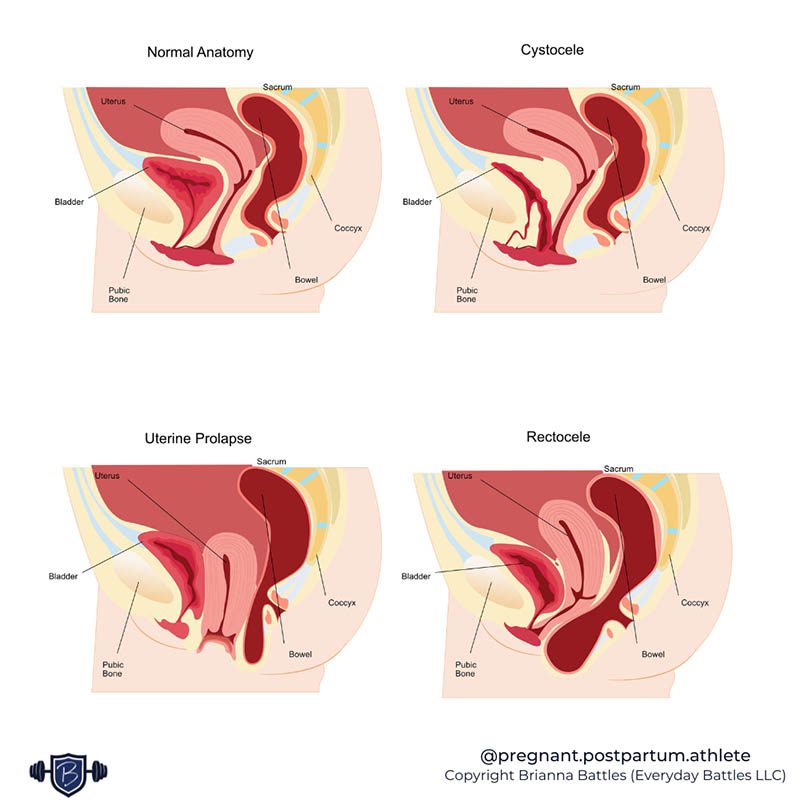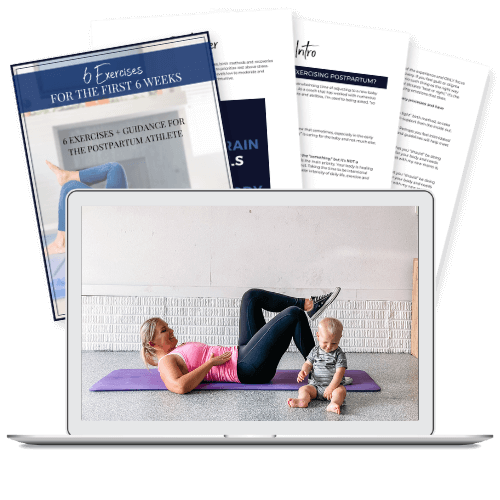When you’ve been diagnosed with pelvic organ prolapse, it can be so easy to fall down a rabbit hole of worry that you can’t exercise with a prolapse. You may see advice that warns you from squatting, running, or high intensity workouts like CrossFit, but that doesn’t have to be the case.
Just because you’ve been diagnosed with prolapse or are experiencing prolapse symptoms doesn’t mean you can’t return to doing the activities that you once loved. Keep reading below for tips on how to continue exercising with prolapse and how to help reduce symptoms with exercise.
What is pelvic organ prolapse?

Pelvic organ prolapse occurs when one or more of the pelvic organs descends or collapses into the vaginal canal. The type of prolapse is named after the pelvic organ that is descending. The most common types of pelvic organ prolapse are: Cystocele (bladder), Rectocele (rectum), and Uterine (uterus).
The presence of pelvic floor symptoms is not correlated with the severity of the prolapse. You can experience valid symptoms with a grade I pelvic organ prolapse. You can also experience no change or reversal of grade yet experience a relief or reversal of symptoms.
Is it OK to exercise with a prolapse?
Yes! Exercising is not only safe to do when you have pelvic organ prolapse, but it can also help you in your pelvic floor recovery. While there are no movements inherently off limits when you have prolapse, there are adjustments that you may need to make in order to reduce your risk of increasing your symptoms.
The following 3 tips can help to make your exercises pelvic floor-safe:
1. Avoid straining and bearing down into your pelvic floor.
While some downward pressure into the pelvic floor is normal, excess pressure or bearing down into the pelvic floor muscles can lead to an increase in prolapse symptoms.
One way to help avoid bearing down into your pelvic floor muscles when you lift is to ensure that you are bracing in a way that equally spreads intraabdominal pressure instead of concentrating pressure downward.
Try breathing into your lats. You’re more likely to get a full ribcage expansion at the start of your brace which helps to prevent you from collapsing at the top of your core and bearing down into your pelvic floor.
Not sure if you’re bearing down when you brace? A movement assessment with a coach or an internal pelvic floor assessment with a pelvic floor physical therapist can help you to determine this.
Bonus tip: Make sure you’re being assessed in the lift position (ex: squatting) and not just lying on your back.
Another way to help reduce bearing down into your pelvic floor is through breathing pattern adjustments.
Try exhaling either through the whole exercise or through the portion of exertion in a lift. By timing this exhale, you’re allowing your body’s natural system to take place where the pelvic floor slightly lifts on exhale.
You don’t have to breathe this way forever. The goal is to practice when needed until your tendency shifts away from bearing down into your pelvic floor.
2. Reduce pelvic floor tension.
When you’re scared that your pelvic floor muscles aren’t supporting you the way they should be, it’s very easy to either consciously or subconsciously want to try to hold everything in by engaging your pelvic floor muscles.
But constantly engaging your pelvic floor muscles, ex: doing a kegel with every rep, holding a kegel while you run, or engaging throughout the day doesn’t allow your pelvic floor to perform optimally. This may actually increase your pelvic floor symptoms.
Your pelvic floor needs both contraction and relaxation. When you’re holding a pelvic floor contraction longer than needed, the pelvic floor muscles tend to become fatigued and unable to rebound as quickly or support with higher loads like they should be.
Instead of holding a pelvic floor contraction, try only contracting when necessary and having the effort of your pelvic floor contraction match the effort of your activity.
For example, carrying your laundry, deadlifting a 35lb kettlebell, and a 250lb barbell deadlift aren’t going to need the same level of bracing or contraction.
3. Form isn’t everything, but it can matter when you exercise with a prolapse.
You don’t need to try to stay in an “optimal” form pattern with all of your movements. That’s not the way we are made to move through daily life. But if your pelvic organ prolapse symptoms are increasing with certain movements, a form shift may help to reduce your pelvic floor symptoms.
For example, if your lifting form or limitations in ankle or thoracic spine mobility have you leaning more forward in a squat, you may have increased pelvic floor pressure with that movement.
By taking a more stacked position with your ribcage over your pelvis, you’re more likely to reduce downward pressure into your pelvic floor and help to reduce your pelvic organ prolapse symptoms with that movement.
You don’t have to give up the fitness and active life that you love – you can exercise with a prolapse! By avoiding bearing down into your pelvic floor, reducing tension, and making small form adjustments, you can help to reduce your pelvic organ prolapse symptoms and return to the workouts that you enjoy.
Want to learn more about your pelvic floor symptoms and exercise? Join us for a FREE workshop to learn the strategies you need to prioritize your safety + performance while being mindful of your core + pelvic floor system.

Read More: Pelvic Floor Pain in Pregnancy: 3 Exercises to Help




